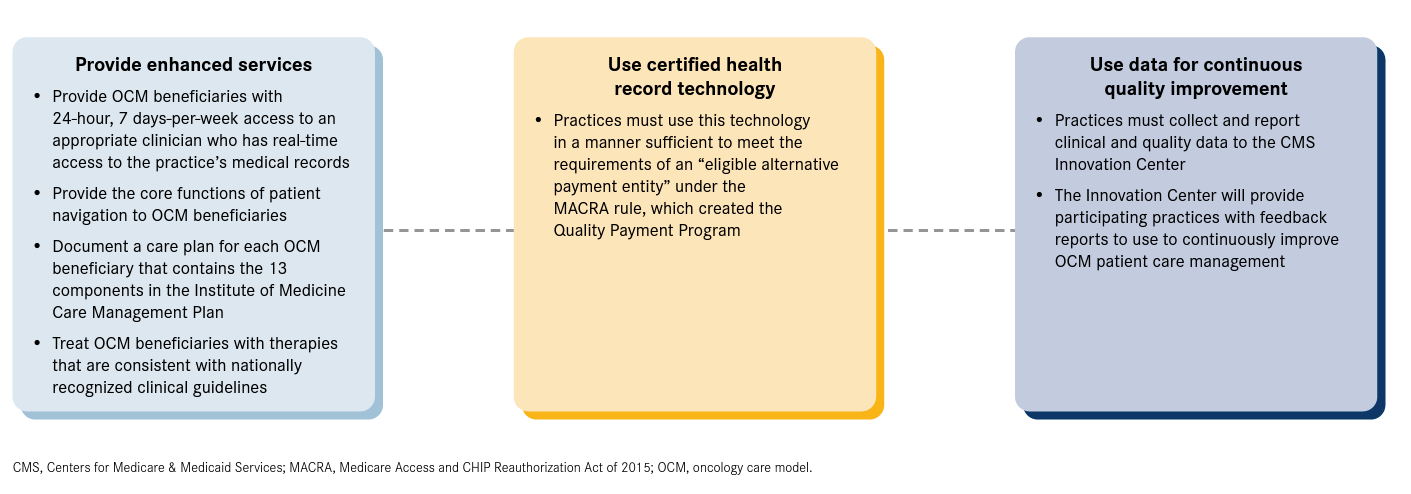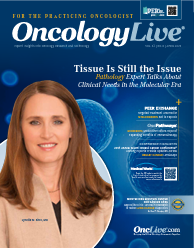Publication
Article
Oncology Live®
Building the Community Oncology Practice of the Future Demands a Comprehensive Approach
As cancer care continues to shift away from a fee-for-service model to a value-based care model, clinicians and institutions will need to be adaptable and innovative to build effective community oncology practices of the future.

As cancer care continues to shift away from a fee-for-service model to a value-based care model, clinicians and institutions will need to be adaptable and innovative to build effective community oncology practices of the future.
“We are part of a large, complicated environment with hospitals, payers, and plan benefit managers, and that creates market pressure and an ongoing market dynamic that we have to compete with,” Glenn Balasky, executive director of Rocky Mountain Cancer Centers in Englewood, Colorado, said in an interview with OncologyLive®. “Value-based care is here to stay. We have community oncology practices that have to leverage that in order to continue to garner attention from the payers and employers alike.”
Balasky participated in a panel discussion at the 2022 Community Oncology Conference in March titled, “Building/Designing the Community Oncology Practice of the Future.”
The 6-year Oncology Care Model (OCM), initiated by the Centers for Medicare & Medicaid Services, was designed to evaluate payment strategies to promote high-quality and high-value cancer care.1 The OCM focuses on providing beneficiaries with enhanced services, such as 24-hour, 7 days-per-week clinician access and a documented care plan, use of electronic health records (EHR), and increased data utilization to improve care (Figure).1 Approximately 25% of fee-for-service chemotherapy-related cancer care—spanning more than 125 practices and 7000 practitioners—has been handled by the OCM. The model debuted July 1, 2016, and is scheduled to expire on June 30, 2022.1
Figure. OCM Practice Redesign Activities1

Balasky said that the OCM is the most comprehensive value-based care model put into practice to date and that it is unfortunate it is being paused without a next step in place. Clinical practice with the OCM has allowed clinicians to gain more experience in providing electronic screening, measurements, and assessments, Balasky noted.
He hopes that practices will continue to be committed to applying these innovations to draw patients, even as the model expires.
Building Blocks for the Future
Expanding communication options
Balasky said that one of the biggest recent shifts in providing value-based cancer care has been in the realm of patient communication. The wide adoption of telemedicine brought on by the COVID-19 pandemic has changed the way clinicians communicate with patients in ways that extend beyond in-person vs virtual visits. Balasky noted the positive innovations that coincide with telemedicine are here to stay, which include new methods of outreach and follow-up as well as expanded offerings.
“We are growing in our ways to connect with patients better,” Balasky said. “We are trying to move away from [just talking on] the phone. It is taking a while, but we’re trying to move into more asynchronous communication, such as texting our patients appointment reminders or allowing them to check in to an appointment online. The service side needs to [continue to] progress. The care side will always progress because we’re naturally driven to provide better care.”
Increased telehealth use has received a positive response from patients, particularly among adolescents and young adults with cancer. A retrospective study by Swartz et al found that among 331 patients who were diagnosed with cancer between the ages of 15 and 39 years, 71.4% participated in telehealth and most of them were somewhat or very satisfied with their telehealth experiences (54.8%). Topics that patients preferred to address via telehealth included nutrition (34.8%), stress management (33.9%), and mental health or counseling services (32%).2
Strategies to increase or continue telehealth services are being considered across the oncology landscape. For example, the National Cancer Institute is conducting a 5-part webinar series running monthly from February 2022 to June 2022 seeking to identify research gaps and opportunities for increased telemedicine use in cancer care.3 Additionally, in March 2022, Congress voted to extend COVID-19 telehealth policies for Medicare patients for an additional 5 months after the public health emergency expires.4
Restructuring to address physician burnout
Balasky also highlighted that labor and wage pressures, largely brought on by the COVID19 pandemic, present a significant challenge for providing value-based care and that issues with staffing shortages resulting from burnout must be addressed.
At the 2021 American Society of Clinical Oncology Annual Meeting, So et al presented the results of a pilot study at a tertiary cancer center in the United Kingdom to address burnout among junior oncologists. The program invited doctors to participate in 30-minute weekly well-being sessions organized by a clinical psychologist. The sessions included breathing and relaxation exercises, clinical debriefing, and suggested strategies to increase mindfulness in the workplace.5
All 10 oncologists who participated in the program were either satisfied or very satisfied with the group facilitation and found the sessions helpful. Interventions that incorporate physician feedback to combat burnout are something that community oncology practices should consider, Balasky contended.
“We are going into a period where we may have no choice but to raise our wages...to keep our staff and fulfill our mission,” Balasky said, noting that the added cost may delay other areas of innovation. “[Not] only do we have to pay them more, but we also have to help engage them more. The pandemic has been hard for everybody in the country and in the world, and [as a result], we have lost some of our connectivity.”
Incorporating advances in care delivery
The increased role of genetic testing for the optimization of cancer care is another factor that will need continued monitoring. During the panel discussion, Balasky said that his practice hired a staff member to exclusively handle payments for genetic testing to accommodate the volume of billing. Balasky noted that genetic testing workflow and operations processes, still in their infancy, must be optimized to address complications with ordering and how clinicians see the results.
The increased prevalence and evolving efficacy of EHRs may present a possible solution to the problem of effectively integrating genetic testing into a value-based health care model. In a retrospective study of an OCM multisite community-based practice, Mendenhall et al looked at the effect of provider education and the addition of discreet data fields to the genetic testing fields added to the EHR concerned to better track the incidence of genetic screenings in patients with breast cancer.6
Results from the study showed that of the 631 patients deemed to have met the National Comprehensive Cancer Network testing criteria, 92.7% were referred for genetic counseling and testing. The new screening practice also resulted in a 163% increase in genetic referrals for other cancer types outside breast cancer. Investigators concluded that the workflow practice was effective, scalable, and financially viable in terms of genetic and practice growth.6
Lessons Learned From the OCM
Even as value-based care appears to be on its way toward permanent integration in oncology care at the community level, challenges in adopting the model remain. For example, results of a 2021 survey of 307 oncologists across the US highlighted some of the barriers to participating and succeeding within a value-based care model. Among practices that participate in commercial value-based care programs (n = 60), half the respondents found it neither easy nor difficult to perform favorably within the model, 30% said it was difficult, and 5% said it was very difficult. Similarly, most practices that participated in the OCM or the Merit-Based Incentive Payment System (n = 150) found favorable performance neither easy nor difficult (51%); 31% and 6% found it difficult or very difficult, respectively.7
The primary challenges for favorable performance among 153 responders who completed the survey included navigating the payer landscape and reimbursements (27%), identifying cost-reduction opportunities (20%), and tracking costs across an episode (18%). Responders were also asked to suggest solutions to better support value-based care reimbursement; the most common answers cited seamless integration into current workflows (49%), increased interoperability across platforms (42%), and increased awareness of cost information (29%), among others.
Survey responders represented practices in the privately owned community setting (44%), the public community setting (29%), and the noncommunity setting (27%). The median time spent in direct patient care was 90% (range, 0%-100%), and the median patient volume per day was 20 (range, 3-60). Investigators concluded that further research is needed to better design and implement value-based care systems and the technology they require.
“The analogy that I have used a lot during the [COVID-19] pandemic is that we [are] in the same storm, just in different boats,” Balasky said. “How do we get our boats back together? How do we line up and continue to learn from each other? How do we continue to do that with the community at large across the country? [We need to] bring that spirit back to our offices, back to our clinics, to give that benefit to our staff, our physicians, and most importantly, our patients.”
References
- Oncology care model overview. Centers for Medicare & Medicaid Services. February 2021. Accessed March 22, 2022. bit.ly/36G3RhS
- Swartz MC, Roth M, George G, et al. Satisfaction with and recommendations to improve telehealth visits among adolescents and young adults with cancer during the COVID-19 pandemic. J Clin Oncol. 2021;39(suppl 28):280. doi:10.1200/JCO.2020.39.28_suppl.280
- Telehealth and cancer: studying its role in cancer control and care delivery webinar series. National Institutes of Health. Updated March 15, 2022. Accessed March 28, 2022. bit.ly/3JMz1CB
- The AMA salutes Congress for passing omnibus telehealth provisions. News release. American Medical Association. March 14, 2022. Accessed March 28, 2022. bit.ly/3uzsbu2
- So AC, Hunter S, Chan K, et al. A pilot study to prevent burnout in junior oncology doctors during the COVID-19 pandemic in a tertiary U.K. center. J Clin Oncol. 2021;39(suppl 15):11015. doi:10.1200/JCO.2021.39.15_suppl.11015
- Mendenhall M, Guinigundo A, Burneka E, et al. Strategic integration of genetic testing and counseling in patients with breast cancer in an oncology care model (OCM) multisite community-based practice. J Clin Oncol. 2021;39(suppl 28):231. doi:10.1200/JCO.2020.39.28_suppl.231
- Gajra A, Simons D, Jeune-Smith Y, Valley AW, Feinberg BA. Barriers to participation and success in value-based care (VBC) models. J Clin Oncol. 2021;39(suppl 28):70. doi:10.1200/JCO.2020.39.28_suppl.70





















%20(2)%201-Recovered-Recovered-Recovered-Recovered-Recovered-Recovered-Recovered-Recovered-Recovered-Recovered-Recovered-Recovered-Recovered-Recovered-Recovered-Recovered-Recovered.jpg?fit=crop&auto=format)
%20(2)%201-Recovered-Recovered-Recovered-Recovered-Recovered-Recovered-Recovered-Recovered-Recovered-Recovered-Recovered-Recovered-Recovered-Recovered-Recovered-Recovered-Recovered.jpg?fit=crop&auto=format)
